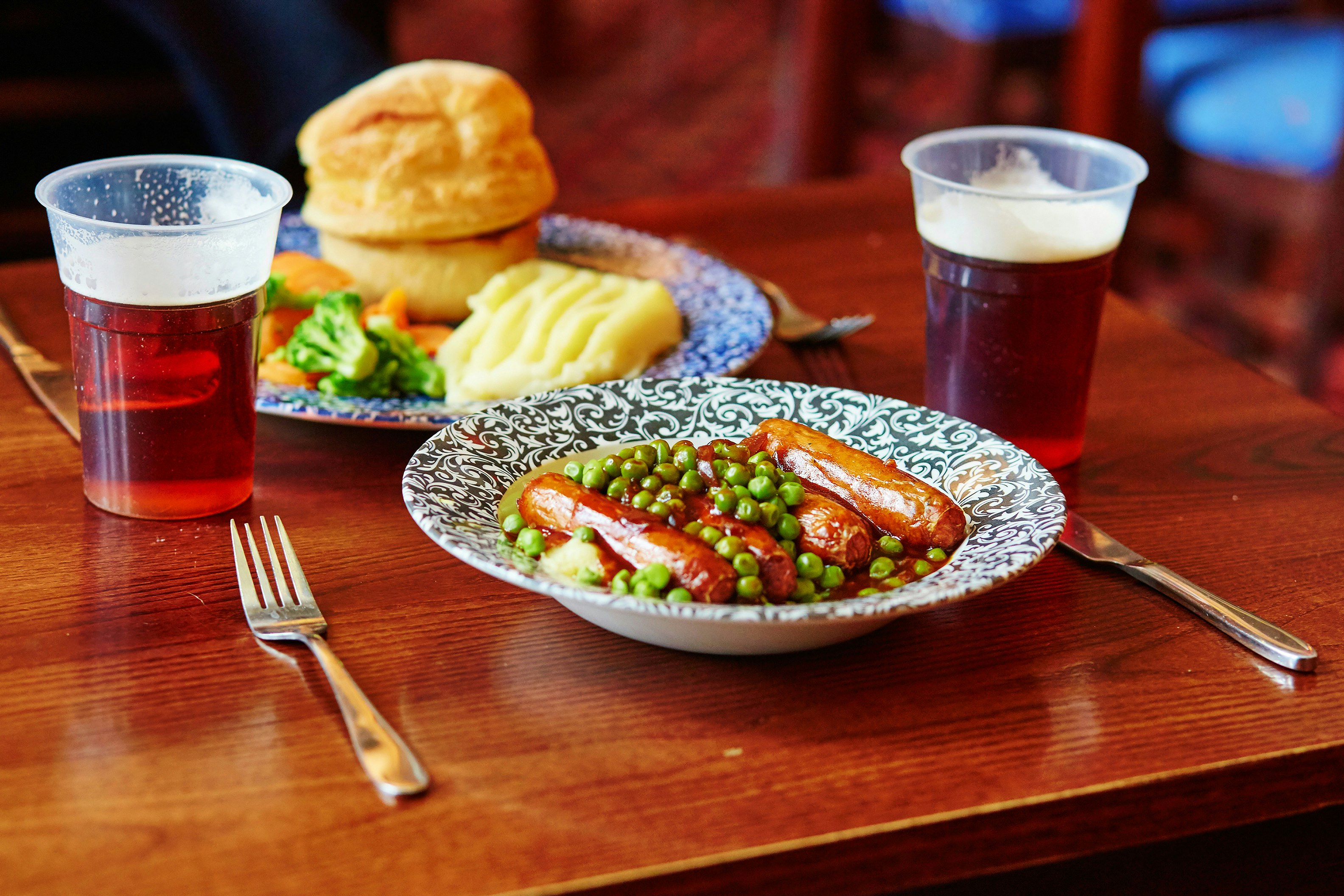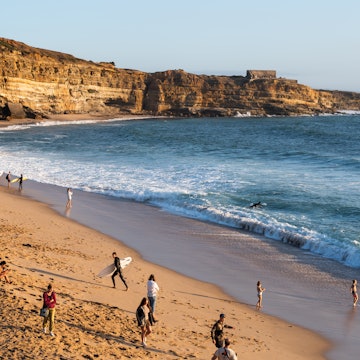

Time your visit for one of England's excellent foodie festivals, like the Whitstable Oyster Festival in Kent © cktravels.com / Shutterstock
Sarnies, toad in the hole, bangers and mash – traditional English cuisine can be as hearty as the lingo is bewildering. Once you've mastered the food slang, you'll find that the dining (and drinking) offerings in England are vast, with plenty of regional specialties and individual quirks.
London is the gastronomic capital of England, with upscale dining, world cuisine and indie venues mixed with chain restaurants and cafes, plus traditional "greasy spoons." Beyond the capital, you'll encounter unique dishes, menus featuring local produce, historic pubs, plus modern microbreweries and distilleries, in villages across the country.
So now you're ready to discover what to eat and drink in England.

1. Have a traditional Sunday roast in a proper pub
Feasting on a sizeable Sunday roast is a sacrosanct English experience and requires an ambitious appetite – especially if plated up by a doting grandmother. Expect large portions of roasted meat and gravy served with assorted vegetables, potatoes and Yorkshire pudding – a savory side made from a simple batter.
Traditionally a beef-heavy meal, roasts were eaten after a Sunday church service, when meat was considered more of a luxury. They've evolved over the years to encompass other meats and some creative vegetarian and vegan options. A Sunday roast is essential pub fare, and everyone has their local favorite to recommend.
Where to try it: The New Inn in St Owen's Cross, Herefordshire, is a cozy 16th-century coaching inn with a solid reputation for quality roasts packed with local produce. Enjoy a filling three-course Sunday lunch next to their warming fireplace.
Read more: Local Bites: the best places to eat and drink in East London

2. Enjoy fish and chips at the seaside
Piping hot fish and chips at the seaside is a staple of British cuisine, best enjoyed after a bracing dip in the ocean. Even on blustery days, few can resist the lure of fryer-fresh chips on the promenade, devoured with a small wooden fork or grease-smeared fingers.
England's national dish typically consists of crispy battered cod or haddock, served with deep-fried chips smothered in salt and malt vinegar. You'll find this classic dish across England in "chippies" (fish and chips shops), cafes and pubs. Even posh gastro pubs will have it on the menu.
The concept of fish fried in batter is thought to have come from immigrants from Spain and Portugal, who brought over this simple cooking method before the English adopted it in the 19th century.
Where to try it: Palm Court Restaurant has a prime spot on Brighton Pier with superb sea views from its glass-fronted restaurant and bar. Order fish and chips and a glass of bubbly and enjoy the seaside ambiance in stylish surroundings.
Read more: Local Bites: the best places to eat and drink in London's West End
3. Eat bangers and mash in a dedicated mash shop
Bangers and mash are feel-good food and a popular pub dish in England. It's a fairly simple recipe: pork or beef sausages are paired with creamy mashed potatoes and garden peas and covered in gravy. The "bangers" half of the meal is an everyday nod to cheap sausages in WWI that would burst open while cooking due to cheap fillers.
This humble dish has come a long way since, with gourmet sausages and plant-based options becoming a fixture on menus in pubs, cafes and dedicated banger and mash shops.
Where to try it: Mother Mash in London specializes in freshly cooked mash served with your choice of posh sausage or plant-based sausage.

4. Treat yourself to a fancy Cream tea
Devon and Cornwall in Southwest England both claim to be the spiritual home of cream tea, with an ongoing friendly rivalry over its historical origin. Cream tea (not to be confused with afternoon tea) is a simple spread of English breakfast tea and freshly baked scones slathered with clotted cream and fruity jam. Many southwestern cafes have made cream tea their specialty, offering upmarket versions that include the finest ornate china, artisan teas and even a cheeky glass of fizz.
Where to try it: Sustainability-focused Cafe Ode in Ness Cove, Devon, serves a homemade cream tea by the coast, with panoramic views of the Atlantic Ocean.
5. Feast on Cornish pasties at England's most southerly point
Cornish pasties are a well-documented part of Cornwall's culinary heritage and can be traced back to the 1200s. These D-shaped pastry parcels have a wide crimped edge and are packed with a tasty mix of beef, potato, onion and swede.
A cheap way to feed a family, they were the preferred portable lunch of Cornish tin miners in the 18th century. Miners would leave the uneaten crusts for the "knockers" – mythical mine-dwelling spirits known for their mischievous nature.
Today, you can enjoy traditional Cornish pasties in cafes and bakeries everywhere in England, with plant-based pasties also becoming more widely available for vegetarians and vegans.
Where to try it: Pick up a hot handmade pasty from Ann's Pasties in the Lizard – England's most southerly point – and wander down the rocky coast path for lunch with an ocean view.

6. Sample craft beers at a microbrewery or local pub
With more than 2000 independent breweries in the UK, it's safe to say that the Brits like an IPA tipple or three. England's craft beer scene has exploded in recent years, with indie brewers pumping out high-quality ales, IPAs and bitters for a thirsty public.
Pub culture is fast catching up to consumer demand for locally produced pints, and you'll now find many small-scale brews available on tap alongside mainstream lagers. A variety of tasting rooms, brewery tours and masterclasses across England also cater to beer aficionados who want to improve their craft ale knowledge.
Where to try it: Award-winning Cloudwater Brew Company has a contemporary taproom in Manchester. Located next to their brewery, visitors can sample new brews and best sellers in the taproom.
7. Vegetarians and vegans, you have options
The rapid rise of veganism in the UK has resulted in a vast increase in plant-based dining options across England. Restaurants and cafes are quickly evolving to keep pace with an increasing demand for meat-free eats and are incorporating more creative plant-based dishes on their menus too. So it's out with boring bean burgers and in with jerk-spiced vegan tacos packed with jackfruit, cayenne pepper, and avocado.
Major English cities like Brighton, Oxford and York now have a huge range of vegan-friendly and eco-minded establishments to choose from, serving herbivore plates and sustainably sourced produce where possible. In more rural areas of England, finding decent vegan options can be a bit more challenging, so you'll need to do your research before your visit. Use handy apps such as Happy Cow to find out what the vegan food scene is like where you're visiting and what your plant-based dining options are.
8. You can even get a vegan version of "the Full English"
Synonymous with British culture, the traditional "Full English" dates right back to the 13th century, when it was the breakfast of choice for the landed gentry. This morning dish typically encompasses a feast of bacon, eggs, sausages, beans and toast, and is generally served with a steaming "cuppa" (that's a cup of tea).
Vegan versions are also becoming increasingly popular with scrambled tofu, faux-bacon and spicy potato hash among the inventive plant-based options.
Where to try it: Check out Café Van Gough in Brixton for delicious vegan brekkies (breakfast) served by a not-for-profit social enterprise located in the grounds of a church.
9. Go to a foodie festival
There's no better way to really deep dive into food culture than immersing yourself in a local food festival. Time your visit to coincide with one of these calendar highlights.
Big Apple Harvestime Visit busy cideries and take in rolling orchard views while sampling local cider and perry at this harvest-time Herefordshire festival in October.
Isle of Man Food and Drink Festival Explore the finest Manx cooking and produce in September on the island in the Irish Sea.
Yorkshire Dales Cheese Festival A celebration of Yorkshire's cheese in the home of Wensleydale with artisan cheesemakers every October.
Porthleven Food Festival Three-day April feast showcasing the best in Cornish produce and flavours.
Whitstable Oyster Festival Celebrate summer on the north Kent coast in oyster-obsessed Whitstable.
Beer on the Wye Riverside beer festival in Hereford every July serving up ales of myriad styles and strengths.
Should I tip at restaurants and bars in England?
In terms of tipping, a discretionary service charge is usually added to your bill. You could refuse to pay it, but that would be unusual. If it's not included, something around 10 to 15% is the norm for table service. You're not expected to tip at the bar.
















